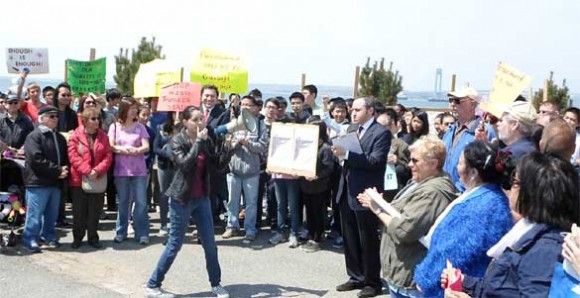In Protesting Bensonhurst Waste Transfer Station, Opponents Say Sandy Gave Another Reason For Caution

On the six month anniversary of Superstorm Sandy yesterday, local politicians, activists, and neighbors gathered once again to decry the waste transfer station proposed for the Bensonhurst waterfront, saying that the station could turn a Sandy-like storm into a toxic maelstrom.
Close to 200 people rallied on Sunday, April 28, on the Bay Parkway Promenade near Ceasar’s Bay to support the cause. Their message was clear: A united Southern Brooklyn will continue to fight and oppose the waste station pitched to stand by 25th Avenue and Bay 41st Street.
Assemblyman William Colton joined Brooklyn activist and New Utrecht High School teacher Mark Treyger to fight against what they say will be a “dire strain on this community.”
Treyger, a City Council candidate and the founder of the Sandy Taskforce Recovery Organized by Neighborhood Groups, or STRONG, said that Bensonhurst is not alone in their efforts.
“Today’s rally showed that this hyperlocal movement has swelled into a South Brooklyn movement.” Treyger said.
Treyger added that Sandy has taught some hard lessons that have bolstered their argument against the waste station.
“This time, our message is stronger. [Superstorm] Sandy showed us, once again, why this dumping station shouldn’t be here,” he said.
In the last big rally against the garbage station in August 2012, Treyger paired with Colton to raise awareness of the toxins lurking in Gravesend Bay that could be stirred up by the dredging required to build the station.
Last August, Colton said: “Scientists have confirmed what many in the community feared…There were unsafe levels of mercury and other harmful toxins found at the bottom of Gravesend Bay. The samples were taken by just scratching the surface rather than by digging deep below the surface where the dredging will reach. This leads others and me to wonder: What other dangers lie further below Gravesend Bay?” asked Colton. “And how will this toxic material impact the adjacent beaches of Coney Island and Manhattan Beach?”
Colton attempted to drive the point home by citing the disastrous effects caused by Superstorm Sandy. Colton stressed his anxiety about the dangerous toxins that will be unearthed in locals’ homes should another coastal storm occur.
“Mold is hard enough to clean out. Imagine if it was mercury,” Colton said.
Ari Kagan, the 45th Assembly Democratic District Leader running for City Council in Sheepshead Bay, agreed.
“It’s not just Bensonhurst that this affects. It’s Brighton… Coney Island… Sheepshead Bay… Bay Ridge. It affects all of us, all over Brooklyn,” Kagan said.
Paying tribute to the local beaches and prominent fishing community, Kagan added: “We need to help the community after Hurricane Sandy, not destroy it. I don’t see a single person in South Brooklyn who supports this. Enough is enough.”
Other activists joined in the cry to ‘Dump the dump,’ citing the neighborhood’s children, elderly, and overall residential population as reasons that the proposed waste station is unsatisfactory.
Ludger Balan, a member of the Urban Divers Estuary Conservancy, said that this quality of life issue isn’t just harmful for Bensonhurst locals, but that it will affect everybody in this borough.
Referencing another daunting idea in the completion of this project, Balan spoke in an interview with Bensonhurst Bean of the 1500 rounds of 20mm munitions discovered from a capsized WWII military barge in Gravesend Bay, the focus of a public statement made during the protest by Ida Sanoff , executive director of the Natural Resources Protective Association. According to Balan, Sanoff and Colton, dredging for this waste site could even lead to an explosion of those munitions.
“They could not have chosen a worse place to put this project,” Balan said.
And now, in the wake of an election year, activists are urging Bensonhurst locals to see where candidates running for office stand in regard to this garbage transfer site.
“We need politicians that are really for the people,” Treyger said.
“The next mayor will have the power to continue or end this. The next mayor will make a decision. Before we vote, we will listen to their position on this issue. You want our votes? Stand with our community. This location is just not suitable,” he said.